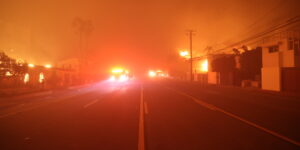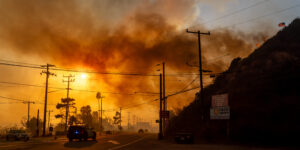Two sets of researchers published analyses of auto crashes recently, with one set identifying speeding at the cause of fatal accidents during the early days of the pandemic, and the other correlating rough roads and slow speeds with accident frequencies before the pandemic. Details follow.
‘Once Traffic Goes Away, People Speed.’
With fewer people on the road during the early days of the pandemic, more drivers were speeding and driving recklessly, resulting in more crashes being deadly.
Researchers at The Ohio State University conducted a detailed analysis of traffic in Franklin County, Ohio, which includes Columbus, from Feb. 1 to May 8, 2020—the period right before and after COVID-19 stay-at-home orders were instituted by the state governor.
While the total number of collisions declined after the lockdown, the proportion of those crashes that were incapacitating or fatal more than doubled, results showed.
“More of the crashes that did occur were severe, not just because of less congestion, but also because of drivers who were speeding, and driving under the influence of alcohol or drugs,” said Jonathan Stiles, lead author of the study and a postdoctoral researcher in geography at Ohio State.
Pandemic driving also led to far fewer rear-end collisions and more single-vehicle crashes, findings revealed.
The study was published this week in the journal Transportation Research Record and will appear in a special issue on COVID-19.
The results reveal a disturbing fact about urban road design, said study co-author Harvey Miller, a professor of geography at Ohio State. “This is more evidence that our streets are designed for speed, not safety,” said Miller, who is also director of Ohio State’s Center for Urban and Regional Analysis.
“What is keeping crashes from being more severe during normal times is higher volumes of traffic, and once traffic goes away, people speed and crashes have more serious consequences.”
The researchers collected crash and traffic volume data for Franklin County from the Ohio Department of Public Safety. They used information from INRIX, a private transportation data company, showing real-time speeds on various segments of major roads and highways in the county. In addition to the real-time speeds, INRIX calculates a reference speed for each road segment, which is the average speed for that segment when there is no major traffic. It is normally close to the speed limit.
Stay-at-home policies were instituted in Ohio on March 15 and continued through the end of the study on May 8.
Traffic volumes declined by more than 60 percent while the stay-at-home order was in effect, the study showed. Vehicle crashes changed in type, time of day and severity when compared to both the period right before the lockdown, as well as the same 55-day period in 2019.
The good news is that crashes were much less frequent in Franklin County under the stay-at-home period, averaging only 24.4 per day compared to 75.8 in the prior year. Collisions were also less prevalent during the morning and afternoon rush hours, compared to the same period in 2019.
Rear-end collisions accounted for only 19 percent of crashes during the lockdown, compared to 35.5 percent a year earlier, while the proportion of single-vehicle crashes nearly doubled, from 12.9 percent to 25.3 percent.
“Rear-end collisions tend to occur when you have a lot of traffic on the roads and that’s one thing we didn’t have during this COVID-19 period,” Stiles said.
“But there was a lot more speed. Single-vehicle crashes are something you would be more likely to see when a driver is traveling at high speed and loses control.”
Crashes in which the reporting officer cited speeding as a factor nearly doubled under the stay-at-home orders compared to the previous year. In an earlier study, some of the same researchers found that speeding by drivers more than tripled in Columbus when comparing 2020 to pre-pandemic 2019.
In addition, more crashes during the lockdown were linked by police to alcohol and drug use.
And more speeding and drug and alcohol use meant more serious crashes. Results showed 3.3% of collisions during the lockdown period were incapacitating or fatal, compared to 1.5% the previous year.
“The odds of a serious crash were still relatively low, but those chances increased significantly with less traffic and higher speeds on the roads,” said study co-author Armita Kar, a doctoral student in geography at Ohio State.
The results have implications for safety and equity, the researchers said.
One issue is that essential workers, who are often low-income and minorities, were the ones most likely to be on the road. “These essential workers had to get to their jobs, so they are the ones who were exposed to the risk of more dangerous collisions,” Miller said. “Of course, sometimes the collisions were their own fault, but not always.”
There’s also the question of what do with roads if traffic volumes decline permanently because of more people working from home—or in the event of another emergency that keeps most people from driving. “If there’s less traffic, many of our roads may be wider than they have to be, which encourages speeding,” Stiles said. “There’s a safety tradeoff.”
Cities should consider implementing proven strategies for slowing traffic, including having fewer lanes in metro areas, according to the researchers. “We need to redesign streets and roads with safety in mind and not just speed,” Miller said.
Jinhyung Lee, a PhD graduate of Ohio State, now at Western University in Canada, was also a co-author on the paper
Rough Roads Lower Traffic Speeds-and Safety
Rough roads and decreasing pavement quality drive up vehicle crash rates and slow down average vehicle speeds, posing major concerns for motorists and highlighting the importance of public transportation spending, West Virginia University economists have concluded.
Brad Humphreys and Alexander Cardazzi, both of the John Chambers College of Business and Economics, found that maintaining smooth roads may lead to increased traffic speeds and decreased crash rates.
Their study, published by the National Bureau of Economic Research, was funded through an interagency agreement between the U.S. Department of Transportation and the National Science Foundation.
“Essentially, we found that rougher roads really impact speed and traffic safety in negative ways, much more so than previously thought,” Cardazzi said.
“If you let the pavement quality deteriorate, it turns it into more of a danger in that road segment in terms of crash rates,” Humphreys said. “We should be concerned about how our road quality is making people travel slower and more likely to have accidents.”
This research provided important evidence on the relationship between highway roughness and traffic outcomes using data from Federal-Aid Highway System roads in California from 2011 to 2019. FAHS roads include interstate highways and U.S. routes.
Data from FAHS showed statistically and economically significant increases in vehicle crash rates and decreases in average vehicle speed caused by road damage. These impacts imply significant increases in social costs attributable to road damage.
Humphreys said that the state of California was chosen for research because high quality data are available for both the quality of the roads and traffic outcomes.
“In California, you have the beach, you have the snow up north, you have the more mountainous places in the east, and you have the desert down south,” Cardazzi said. “There’s all sorts of really good geographic variation that we can take advantage of and see how different climates impact this smoothness.”
Humphreys added that California also has large cities and rural areas, which is beneficial because there’s more opportunity to test a variety of different roads.
This research translates directly to roads in West Virginia.
“These results are probably magnified in West Virginia because our roads are, on average, much rougher or much lower quality than anywhere in California,” Humphreys said.
Their findings also reveal significant social costs, in the form of reduced traffic safety, increased vehicle operating costs and longer travel times. These costs underscore the need for changes in current transportation infrastructure investment policies, they said.
Humphreys said that there is a benefit to road maintenance and the results of this study help inform decisions to interrupt traffic flow on highways and interstates to improve pavement quality.
“People are going to be able to drive at higher speeds,” Humphreys said. “They can get to where they’re going faster along that stretch of interstate and there’s going to be fewer crashes because of that maintenance. It’s costly to slow people down and not let them be able to drive at highway speeds. Accidents are really costly and so that should help us to place those huge maintenance projects in an economic context.”
Humphreys said that currently the United States is debating a $1 trillion infrastructure bill, much of it directed to road improvement.
“Our research really provides important justification for why we might want to spend a trillion dollars or hundreds of billions of dollars improving road quality, because we generate important evidence that society will benefit from that,” Humphreys said. “With that debate going on, I think it’s important to have really solid evidence like the evidence we’ve generated in this paper, that is worthwhile.”
Study: Where the Rubber Meets the Road: Pavement Damage Reduces Traffic Safety and Speed
Sources: Ohio State University; West Virginia University





















 Global Property Catastrophe Rates-on-Line Down 6.6% During Renewals: Guy Carpenter
Global Property Catastrophe Rates-on-Line Down 6.6% During Renewals: Guy Carpenter  2025 Underwriting Profit and ‘Shop-a-Palooza’ Predicted for Auto Insurance
2025 Underwriting Profit and ‘Shop-a-Palooza’ Predicted for Auto Insurance  Surviving the ‘Silver Tsunami’: Closing the Talent, Skills Gap in Underwriting
Surviving the ‘Silver Tsunami’: Closing the Talent, Skills Gap in Underwriting  Moody’s Global P/C Outlook Now Stable Despite Past-Peak Commercial Pricing
Moody’s Global P/C Outlook Now Stable Despite Past-Peak Commercial Pricing 